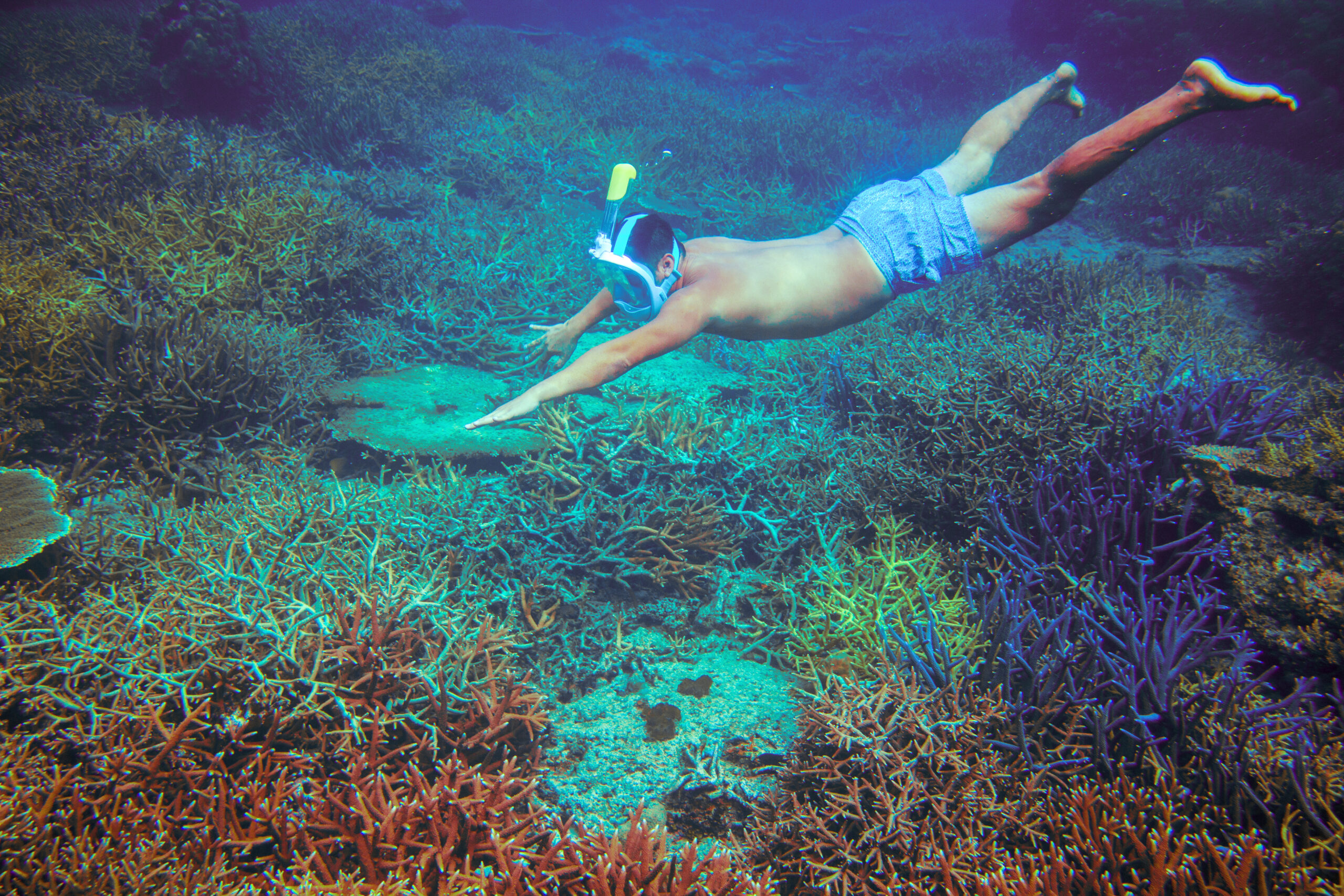Since their introduction in 2014, full face snorkel masks have become very popular. However, as with any new product, there have been some reports on full face snorkel mask dangers. If you are thinking of buying one, you may be wondering if this new type of snorkeling mask is safe. So, let us help. As with most products, you get what you pay for; but with full face snorkel masks, you might not just be saving money but putting yourself in danger. There have been several deaths attributed to these masks, but there are ways to reduce the risks. If you have heard about snorkeling deaths in Hawaii this was likely mentioned as there was a spate of snorkeling deaths there in 2018, which may be linked to these masks.
So, what would include full face snorkel mask dangers? We’re going to look at how they work, why they can be dangerous, and hopefully provide some tips on keeping safe.
How Do Full Face Masks Work?
Full face snorkel masks cover the entire face and allow snorkelers to breathe through their nose or mouth, with the dry snorkel at the top keeping water out while letting in air. They reduce the need for a separate mask and snorkel, have a greater field of view, and are often considered more comfortable to wear and use than the traditional mask and snorkel set-ups.
Full face masks are for relaxed, comfortable surface use. They are not suitable for swimming or freediving; any activity requiring exertion will cause CO2 to build-up (which will be discussed below). High-quality full face snorkel masks have the mouth and nose section sealed off from the eyes, reducing the dead air space inside the mask. Valves at the top of the snorkel will only allow fresh air, while CO2 pushes through the lower section. Cheap, poor quality masks will either not have these safety features, or they may be faulty.
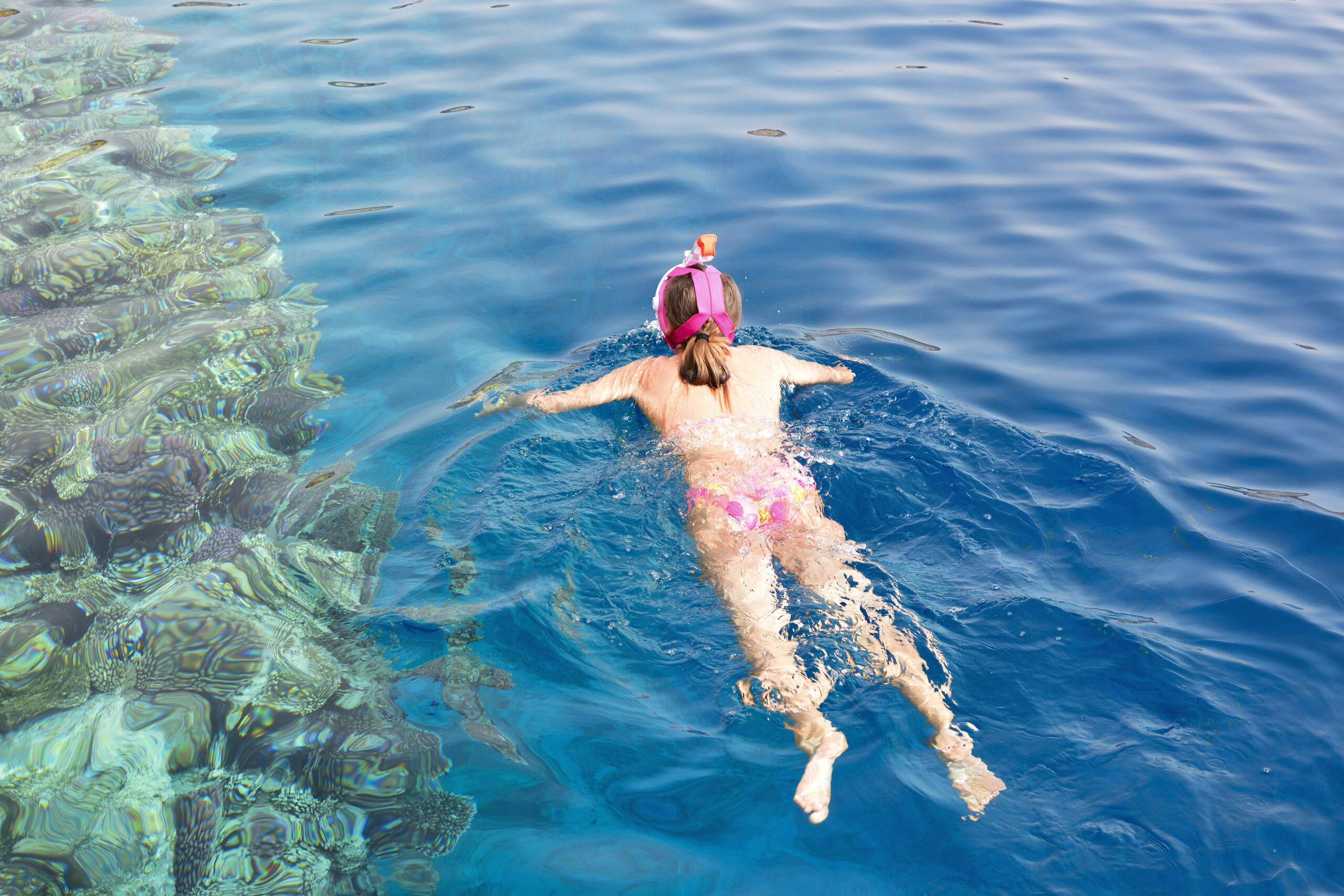
CO2 Build-Up
When you breathe in and out of a traditional snorkel, some exhaled air remains in the tube and is re-inhaled on the next breath. Exhaled air contains Carbon Dioxide (CO2). This remaining air is ‘dead air space,’ and due to the design of full face snorkel masks, the dead air space is more significant than that of a regular snorkel. This means that there is a more considerable build-up of CO2 in full face masks. If the CO2 isn’t circulated out of the mask effectively, it will build up and lead to increased respiratory rate, dizziness, nausea, cardiac difficulties, or even unconsciousness. High levels of CO2 can cause comas, convulsions, or death. Any of these could be a problem by themselves, but in the water, they could also lead to drowning.
Well-designed full face masks circulate the CO2 out effectively, but it is essential to breathe properly when using them. Fully exhaling will help to push dead air and it’s high CO2 content out of the mask, allowing fresh air and more oxygen into your lungs on the next breath. Any strenuous activity requires more oxygen to keep our muscles working effectively, and so we breathe faster. We also tend to breathe less deeply, causing problems with CO2 build-up if we are breathing inside a mask. Shallow breaths mean we do not exhale forcefully enough to push the CO2 out of the mask. Good quality products are designed to reduce full face snorkel mask CO2 build-up by separating the breathing and vision areas of the mask to reduce dead air space. So, let’s see how they work!
Valves at the top of the breathing section allow fresh air in, while CO2 rich air is pushed away through the sides. If a mask does not have this separation or the seal between the two is not effective, the internal volume of the mask is too big to be safe. The expelled air should not reach the top part of the mask, so if your mask fogs while using it, it is a warning sign as the visual part of the mask should remain clear in use. While there are trusted brands that take full face snorkel mask safety seriously, there are also copycats around who have not considered the dangers when creating their products. They may have attractive prices, but they are not safe to use.
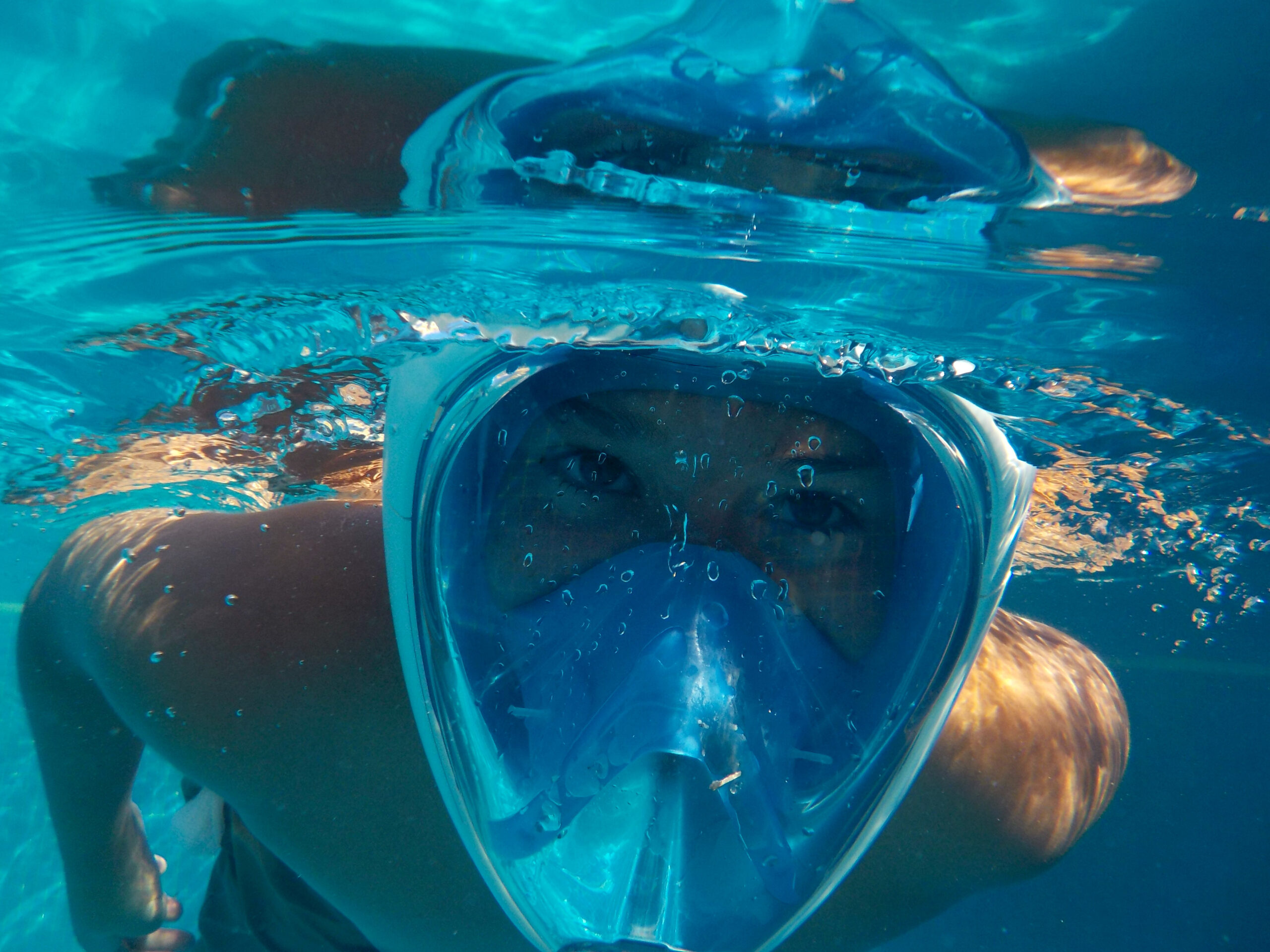
Straps and Seals
Due to the straps needed to keep an all-in-one snorkel mask in place, they are harder to remove than traditional masks, so it is essential to make sure you practice putting them on and taking them off before using them in the water. That way, if you find yourself in a situation where you need to remove the mask, you’ll be able to do so without panicking, which could lead to injury or death.
All masks have the potential to have seal issues. If your mask doesn’t seal properly with a traditional mask, you can keep breathing through your snorkel and adjust the mask to fit better against your face. One of the full face snorkel mask dangers to be aware of is that if the seals on these are not right, you will be dealing with more than just salt water stinging your eyes while you adjust the fit. A leaking full face mask can also interfere with your breathing as the water reaches your mouth and nose. This in itself may cause panic, and the problem will be compounded if you cannot remove the mask quickly and calmly.
So, with this new type of snorkel, it’s essential to make sure you buy one with soft, consistent seals that will prevent water from entering, and also ensure that the seals are firmly against your face and secured well with the straps. This should be tested in shallow water before venturing any further, preferably in a pool. You should also practice taking the mask off on land before going into the water. When you use the mask for snorkeling, enter the water slowly and check you have a good seal before you start. As with traditional snorkels, full face snorkel mask safety is enhanced by having a snorkeling buddy; don’t use them on your own! Check straps are in good condition and don’t use the equipment if anything isn’t right.
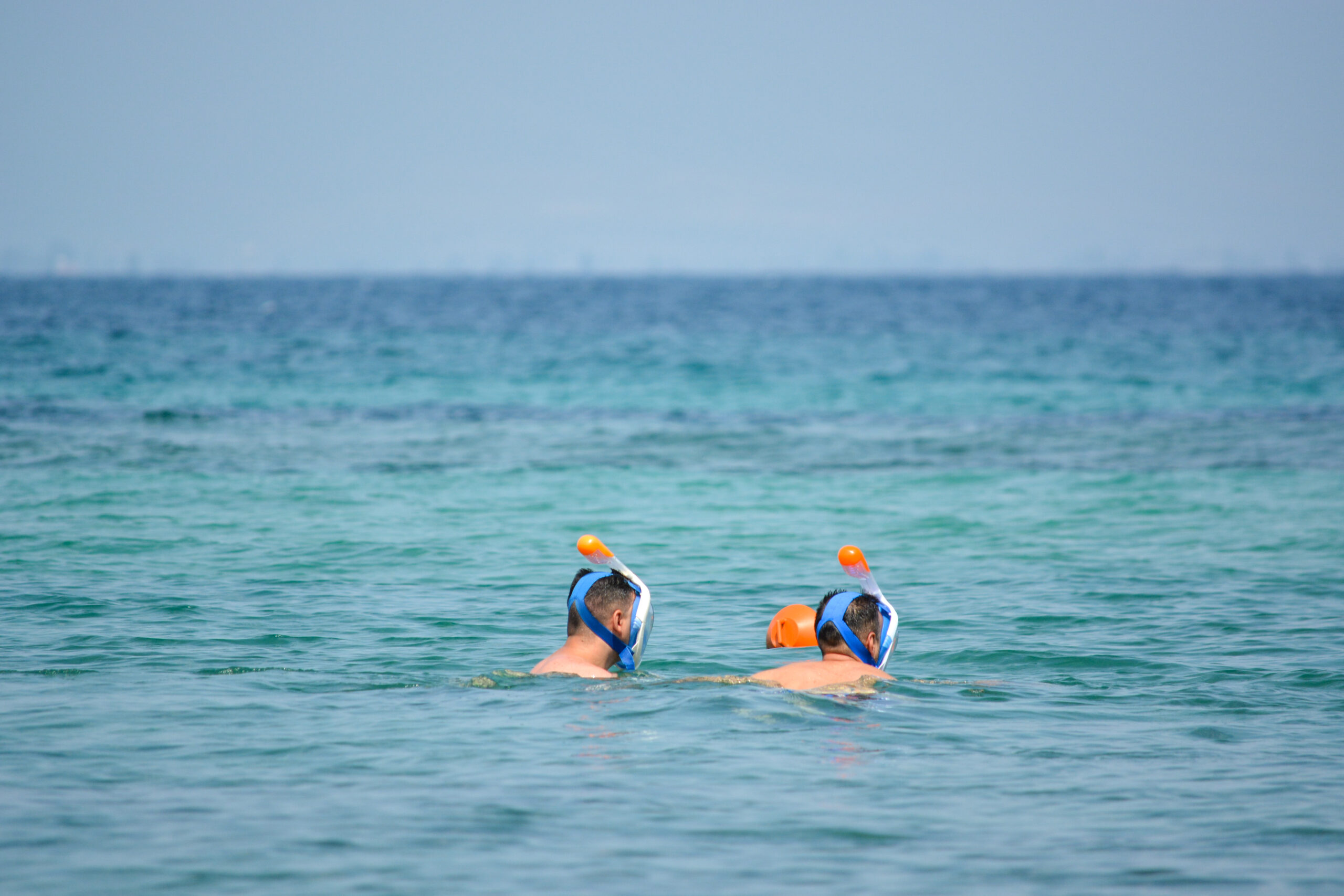
Proper Use and Safe Practice
Snorkeling doesn’t require any form of certification, and anyone can buy snorkeling gear, including full face masks, which is likely a cause of full face snorkel mask deaths. These masks are only designed for use on the surface, but lack of knowledge may lead to misuse. Instructions may not be read or may be inadequate, poorly translated, or non-existent with cheaper products. Full face masks are not for freediving or swimming, but because they are so comfortable, people using them may feel a false sense of security and find themselves in trouble. It’s not possible to equalize your ears easily in such a mask, which can cause ear damage, and with increasing depth, the mask pushes against the face, which may be painful. On the return to the surface, decreasing pressure may loosen the mask, which will then flood. As full face masks are harder to remove and can’t be cleared easily like regular masks, this could result in panic and drowning.
When using a mask with a built in snorkel, you should not be leaving the surface. They are for floating on the surface and looking at the beautiful sights underwater, not for going underwater. The exertion will increase CO2 build up in the mask, and this is something you want to avoid. If you need to swim or want to free dive, you need to be using a standard mask and snorkel that is better suited to these activities. You may have seen photos of people swimming underwater in full face masks but do not try and copy this because it is hazardous.
Full face snorkel mask dangers are managed by making sure you have chosen a good quality product. Still, even with these, you need to be aware of the risks and remove the mask immediately if you experience breathing difficulty, find yourself breathing more heavily, or feel dizzy or sleepy. Some users have reported feeling claustrophobic in a full face mask; if this is the case, you would be better off using a traditional mask and snorkel set up. Whichever equipment you choose, it’s essential to get comfortable with it in shallow water before going any deeper. Ensure you are comfortable, have good seals, and know how to remove your mask if necessary. Remember, with a full face mask, you need to remove the whole thing and maintain the ability to breathe, whereas with a standard mask you can remove that without taking your snorkel out of your mouth.
Ensure your mask fits well; the straps should not be too loose or too tight, and the seals should be consistent. Ensure you don’t have any hair or material between the mask and your skin, and ensure the snorkel is pointing upwards away from the water!
Whether you use a full face mask or a mask and snorkel, never snorkel alone; have at least one other person with you so you can help each other out if you encounter any difficulties. Pay attention to sea conditions, currents, depths, and tides, and don’t overexert yourself.
Quality Full Face Masks vs. Cheap Copies
As we’ve already mentioned, some companies have put many resources into researching, developing, and testing their full face masks to ensure that they are as safe as possible. Knock-off full face snorkel masks, however, are readily available and cheap. The success of full face snorkel masks has led to poorly designed copies, but unlike cheap copies of handbags or clothing, these products are inherently dangerous. Low-cost full face snorkel masks will not have gone through the same design and testing process as those from well-known manufacturers and do not have the same standard of safety measures built-in. They have often gone through no standards compliance testing, so there is no way of knowing if they are safe or not.
Buying cheaper versions is tempting because they seem to be such good value, or maybe you want to try a cheap one before committing to the cost of a quality product from a trusted brand. Hopefully, what you have read here will convince you that it is worth spending more on a quality product that considers safety. A good full face mask will have one-way valves to divert expelled air away from the mask (so you are breathing the freshest air possible) and will have good seals around your face and in between the lower and upper portions of the mask interior.
Cheap masks will not only be designed poorly; they have inferior materials, and critical parts such as valves, straps, and seals will not be of high enough quality to be comfortable or safe.
Take a look at our reviews of the Best Full Face Snorkel Masks to find out more about the features available. By reading our buyer’s guide, you will get some tips on what to look for if you are thinking of purchasing a full face snorkel mask. It’s also worth reading reviews of any mask you are thinking of purchasing, as these will likely highlight any problems with the masks.
If your budget doesn’t stretch to a quality full face mask, then it would be better to get a separate mask and snorkel; it will be more comfortable to use and much safer than a cheap knock off full face mask.
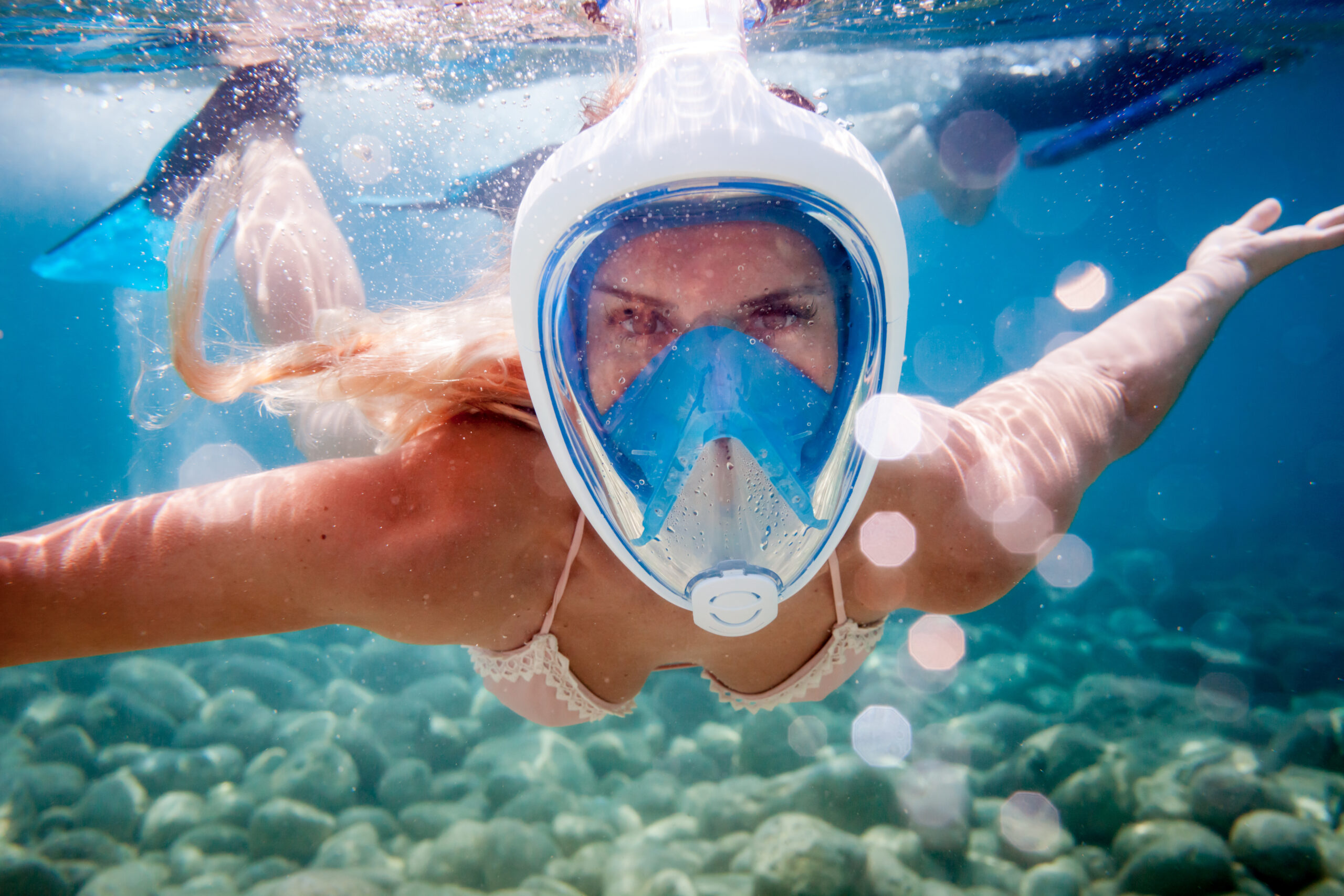
Are Full-Face Snorkel Masks Dangerous?
Well designed, quality full face snorkel masks from reliable, established brands are designed to prevent CO2 build up and are not dangerous so long as you know how to use them properly. Remember that they are only suitable for use on the surface as it’s not possible to equalize the pressure in your ears. Be sure to practice with your mask before using it in the water to ensure you can remove it quickly if required. It’s best to test your mask out in a pool or confined water before using it in the ocean; that way, you can check it fits well, and you are comfortable using it and removing it.
These masks are not for swimming or free diving or use in any challenging conditions. Stay in calm waters and be aware of your surroundings and any signs or instructions regarding waves, currents, and safety in the water.
If you consider full face snorkel versus traditional masks, the traditional ones are less risky as it is possible to keep breathing through the snorkel even if the mask floods. Separate masks are easier to remove as the straps are less complicated. A traditional mask and snorkel are necessary if you want to go below the surface.
Any activity in the ocean comes with risks, and it’s essential that you take these into account when snorkeling, whichever equipment you opt to use. Various agencies offer classes and courses on how to snorkel safely. If you are a beginner, it is well worth getting some instruction or advice on how to snorkel so you can enjoy it while staying safe.
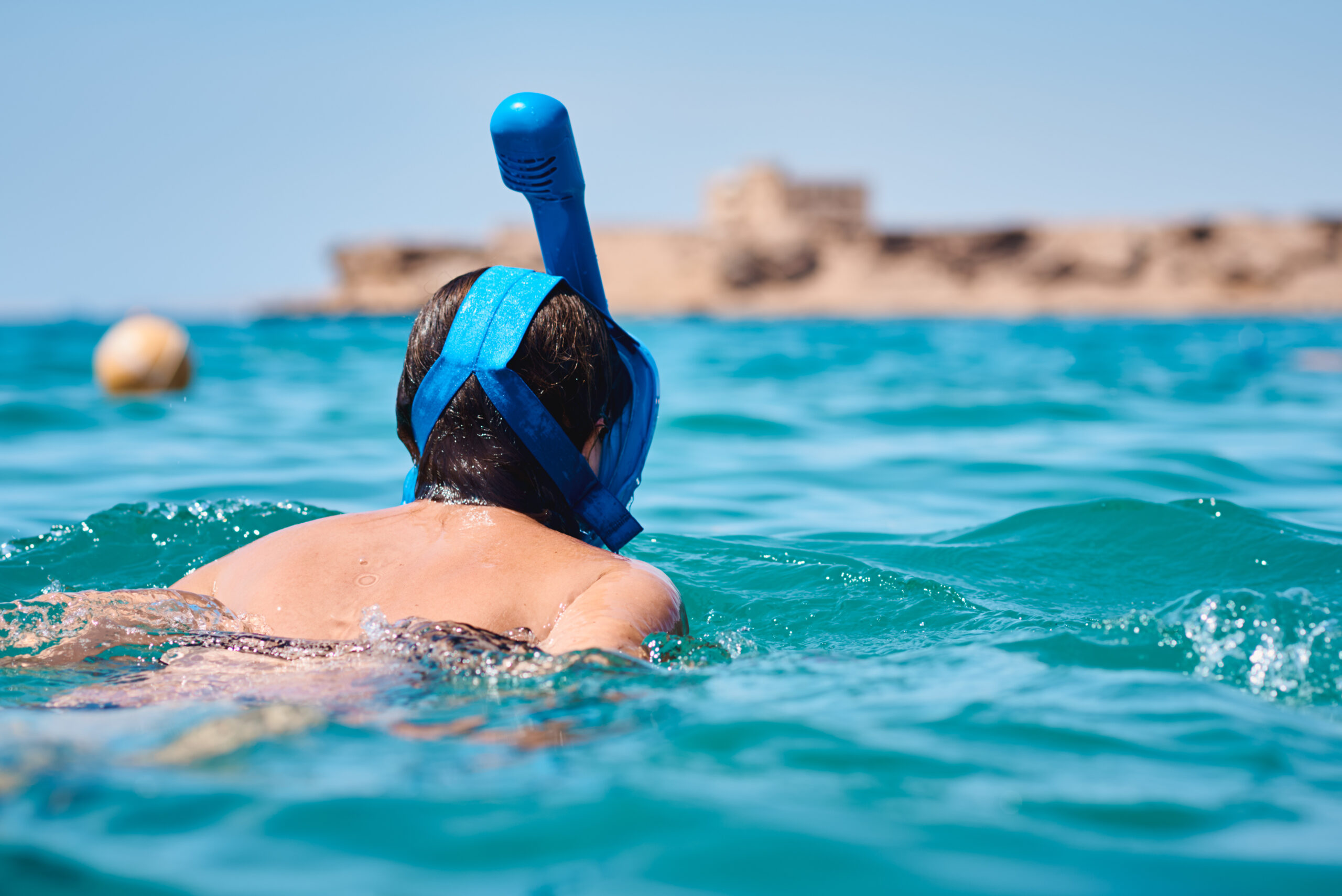
FINAL THOUGHTS
Since 2014 full face snorkel masks have grown in popularity with snorkelers everywhere. They offer a more natural style of breathing and a greater field of view, but people are wondering are full face snorkel masks safe? News of full face snorkel mask deaths has raised serious concerns, but the evidence so far is inconclusive even in the case of full face snorkel masks and the Hawaii deaths.
Full face snorkel masks from respected brands are designed with safety in mind to help avoid full face snorkel mask dangers. It’s essential to be aware of the risks and know how to properly use this equipment to prevent CO2 build-up and remove the mask quickly in an emergency. Avoid cheap full face masks at all costs as they are not safe to use; stick with trusted, well-known brands, and stay safe!
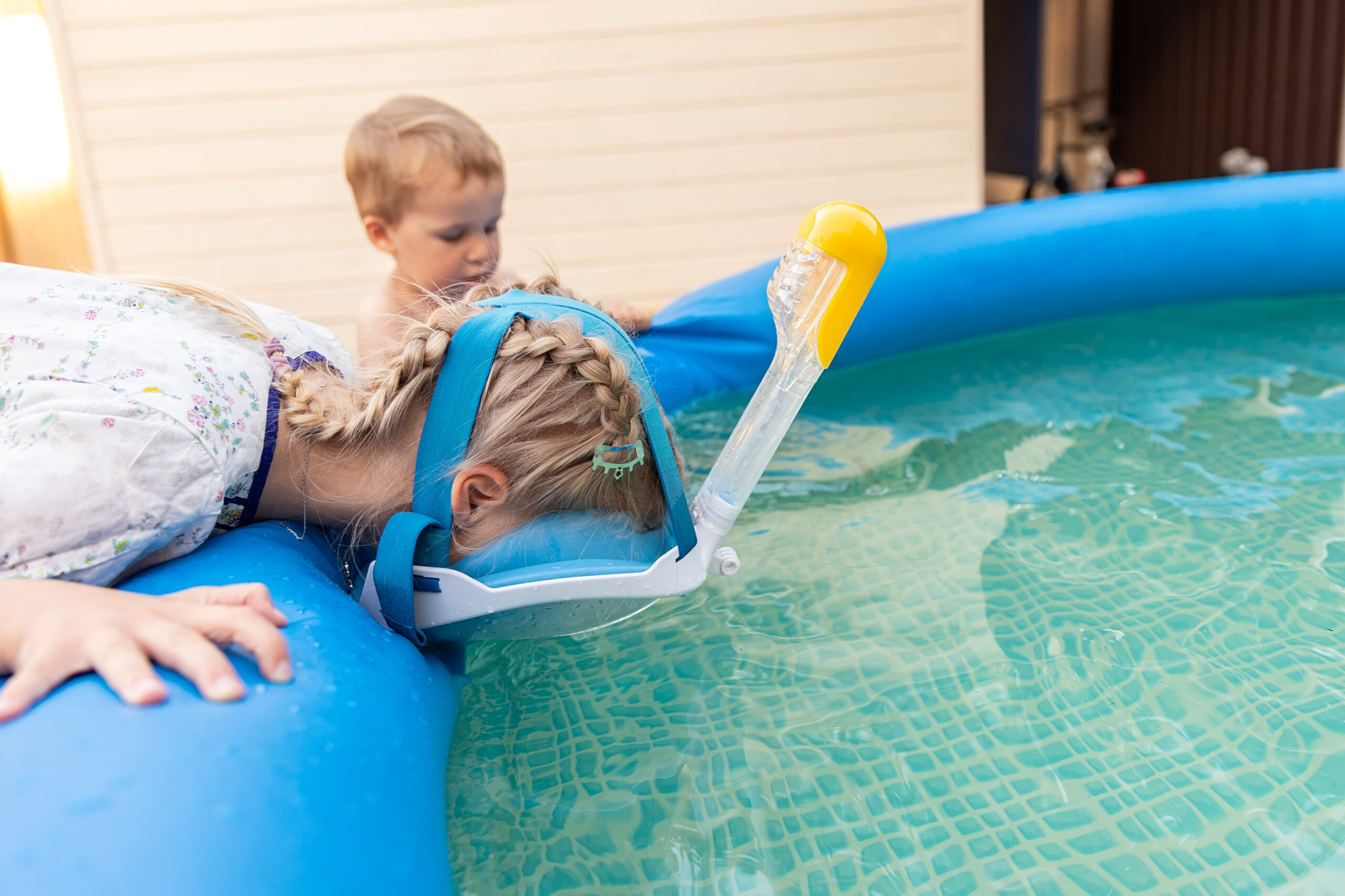
FAQs
Full Face Snorkel Mask Dangers
Are Full Face Snorkel Masks Banned in Hawaii?
Following a spate of snorkeling deaths, Hawaii has been a highlight in the news headlines. Several snorkel tour operators in Hawaii have banned full face masks following an increase in snorkeling deaths during 2018, which many blamed on full face masks. The evidence regarding the increase in death is inconclusive, and while drowning is the leading cause of tourist deaths in Hawaii, there was an increase in tourism, which meant more people were in the water. However, there are no records of what equipment was involved, so it is speculative to say that full face masks were to blame. There are always risks when we do anything in the ocean, and conditions in Hawaii can be difficult even for experienced swimmers.
Snorkeling deaths have occurred using both full face snorkel masks and traditional snorkels, with an average of 18 drowning deaths per year in Hawaii, mainly involving tourists. These often involve underlying health conditions, highlighting that you should be in reasonably good health if you are going snorkeling. If you are going to Hawaii and want to use a full face snorkel mask, you should check with your snorkel operator to see if they allow them to be used.
Can You Breathe Underwater with The Full Face Snorkel Mask?
No, you can’t breathe underwater with a full face snorkel mask or any other kind of snorkel. Snorkels allow you to breathe with your face in the water to see what’s below and around you, but if you want to descend below the surface, you will need to hold your breath to avoid inhaling water. For you to breathe, the top of the snorkel must be above the water to allow air in. Alternatively, you can learn to scuba dive, giving you more time underwater than free-diving does.
If you are interested in freediving, then you will need a separate mask and snorkel. Full face snorkel masks are not suitable for use underwater as they are designed for leisurely use on the surface. Equalizing the ears is difficult with these masks, and the snorkels are much harder to clear of water when resurfacing. Mask squeeze is also more problematic due to the larger air space, and when returning to the surface, there is a possibility of seals losing their grip, causing water to enter the mask.
What Is the Safest Full Face Snorkel Mask?
Brands such as Ocean Reef, Decathlon, HEAD/Mares, and SEAC are all known for producing properly researched, quality full face masks and putting safety first. However, the safest mask for any person will not just be from a trusted brand. It also needs to fit correctly to be safe. To find the safest mask for you, it’s essential to go for a well-known brand and then make sure your mask fits well and seals where it should.
And once you have your mask, be sure to follow the manufacturer’s instructions and stay on the surface. Be sure to know the signs of CO2 build-up, how to remove your mask and keep it in good condition and never snorkel alone.
How Do You Use a Full Face Snorkelling Mask Correctly?
Once you make sure your mask fits well, the seals are snug against your face, and there are no leaks, and you have practiced removing the mask so you can do it quickly and confidently. Take it easy, full face masks are not designed for swimming fast but for seeing what’s under the surface in a relaxed manner. Stay on the surface and enjoy the view; if you want to dive down deeper, then you’ll need a traditional mask and snorkel to free dive, or you could look into getting a scuba certification.
You need to be in reasonably good health to snorkel with any equipment as it is a physical activity. Snorkelers should be comfortable in the water, never snorkel alone, and pay attention to the weather and sea conditions. If using a full face mask, it’s crucial to know and recognize the signs of CO2 build-up as well; if you or a buddy feel sleepy or dizzy or are finding it hard to breathe normally, then you must stop and remove the mask. Practice in a pool or calm, shallow water before venturing into the ocean, and make sure you can remove the mask if you need to.
Are Full Face Snorkel Masks Safe for Kids?
Some commentators will say no when asked are full face snorkel masks safe for children. This is mainly down to the concern that children will not use them correctly, which would be dangerous. We’d advise that you never let kids snorkel unsupervised no matter what equipment they are using, especially if they are using full face masks. The dangers for kids are the same as for adults, but they may not fully appreciate them, so you must explain how to use the masks and their limitations. Make sure your kids do not dive down underwater and get them to practice removing the masks before they go into the water. If your children are interested in snorkeling, it would be worth enrolling them in a course with one of the agencies that can teach them the correct technique to stay safe in the water.
Can You Drown While Using A Full Face Snorkeling Mask?
Yes, you can, and there are more risks with full face snorkel masks than traditional snorkeling equipment. If a full face mask floods, it is harder to clear and trickier to remove than a standard mask. As water may enter the area around your mouth and nose, there is an increased risk of drowning.
To keep safe, you need to be comfortable in the water and capable of swimming without aids or assistance. If using a full face snorkel mask, make sure you follow the manufacturer’s instructions. Know how to remove your mask if you get into difficulty, as any problems with the seals on your mask will cause water to get into the space you are breathing from, which could lead to drowning. Additionally, understand the risks of CO2 build-up, recognize it, and be prepared to remove your mask if you experience any symptoms, as they could also lead to drowning.
SOURCES
How to choose a wetsuit for Watersports
- Are Full Face Snorkel Masks Safe? (Read This Before You Buy One) – scubadivingearth.com
- How safe are full face masks? – seadragonlife.com
- Are Full Face Snorkeling Masks dangerous? – daneurope.org
- Full Face Snorkel Mask Dangers – scubadoctor.com
- Are Full-Face Snorkel Masks Dangerous? – aquasportsplanet.com
- Carbon Dioxide in Full Face Masks – simplyscuba.com
REACH OUT
We hope you found this content informative! If you are looking to expand your scuba knowledge base further, we have written a similar article on the recommended best practices of scuba diving during pregnancy. We have also written some enlightening conservation pieces on the incredible marine mammals and awesome sharks that give our oceans so much character.
As always, we create our content with you, our fellow ocean lovers, in mind. So, feel free to tell us how we did. Did you find what you were looking for? Did it help you arrive at a decision? Did we miss anything out? We’d love to hear from you below.
Thanks for reading and we hope your next dive is a great one – keep diving Blue!


